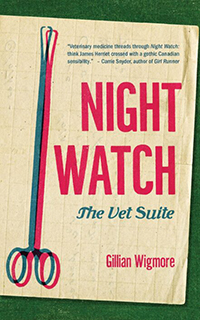Reviews
Fiction Review by Marisa Grizenko
Gillian Wigmore, Night Watch: The Vet Suite (Picton: Invisible Publishing, 2021). Paperbound, 152 pp., $19.95.
 Night Watch is a suite of three novellas focused on veterinarians and the people in their lives. In the first, “Love, Ramona,” we encounter Ramona at three different periods of her life: at eighteen, on a trip to France to meet up with her childhood crush, Louie; at twenty‐four, on a trip to Fiji with Charlie, her veterinarian fiancé, and with Louie and his girlfriend; and at thirty‐five, when Louie comes to comfort her after Charlie’s unexpected death. Despite Charlie’s vocation, he’s a minor character, with the unresolved dynamic between Ramona and Louie taking centre stage.
Night Watch is a suite of three novellas focused on veterinarians and the people in their lives. In the first, “Love, Ramona,” we encounter Ramona at three different periods of her life: at eighteen, on a trip to France to meet up with her childhood crush, Louie; at twenty‐four, on a trip to Fiji with Charlie, her veterinarian fiancé, and with Louie and his girlfriend; and at thirty‐five, when Louie comes to comfort her after Charlie’s unexpected death. Despite Charlie’s vocation, he’s a minor character, with the unresolved dynamic between Ramona and Louie taking centre stage.
The other two novellas focus much more directly on the challenges and joys of a veterinarian’s life. In “Bare Limbs in Summer Heat,” Celia accompanies her brother, Dustin, on a farm call and finds herself reflecting on their diverging life paths. He has inherited their father’s veterinary practice and, to her, the status of “Best Child Ever Forever and Always.” Now a mother and wife, she both resents and is impressed by Dustin’s vocation while yearning for the closeness of their childhood. The last novella, “Night Watch,” uses vignettes to follow Tom Gunn, whose martyr‐like devotion to his veterinary practice makes him indispensable to his rural community even as it threatens his relationship with his boyfriend, Hugh.
The veterinarians of Night Watch, mired in blood, amniotic fluid, and excrement, attend to cows with prolapsed uteruses, pull stillborn calves from the womb, and massage puppies back to life. It’s messy, exhausting, and often heartbreaking work, which Wigmore treats with unflinching attention and precision. The challenges of the job are best illustrated in “Night Watch,” as Tom endures skipped meals, little sleep, and a never‐ending caseload filled with life‐or‐death situations. In the book’s acknowledgments, Wigmore credits her father’s rural practice for teaching her about the “demanding, sorrowful, inspiring and horrifying” aspects of veterinary medicine and for handling even the toughest decisions with tenderness and care. This intimate knowledge of veterinary life is felt throughout the book, evident in Wigmore’s nuanced portrayal of the farmers tasked with balancing economic and ethical considerations as much as in the step‐by‐step surgical procedures undertaken in barns late at night.
For these reasons, Night Watch is at its strongest in the two novellas focused directly on veterinarians. Less successful is “Love, Ramona,” in which exposition and flashback do most of the work in establishing the stakes of Ramona’s meetings with Louie. We’re told of their connection, of the intimacy forged through letters and mixtapes, but when they actually meet, their dialogue is flat and their connection, purportedly so strong they have travelled great distances to see each other over the years, feels unconvincing.
Curiously, we are also told little of Charlie, Ramona’s veterinarian husband. When we first encounter him, he’s a confident, slightly brash young man who enjoys “the puzzle of vet medicine” more than he likes animals. In fact, Ramona recalls witnessing Charlie deliver a punch to a Holstein’s head and laughing it off when he gets caught. In the novella’s last chapter, though, after Charlie has passed, there are hints his attitude had changed. Ramona remembers Charlie’s joke “that he wanted to die with the dogs at his clinic.” Condolence cards attesting to his life‐changing work spill out of her mailbox. This transformation in his character, if it has occurred, is hinted at more than explored. Ultimately, the brevity and episodic quality of “Love, Ramona” fail to serve its narrative ambitions.
However, all three novellas are noteworthy for the way they foreground the physical world. In these stories, characters reckon with disappointment and difficult decisions, but their emotional and psychological struggles are never far removed from the realm of the body. They sweat, cry, delight in physical touch, and experience pain, thirst, and hunger, their embodiment linking them to the animals in their midst. For example, in “Bare Limbs in Summer Heat,” Celia watches Dustin care for a labouring cow. The scene prompts her to recall her own Caesarean, how she too felt “the indignity of needing help” and having to passively endure the “matter‐of‐fact invasion” of her body. In “Love, Ramona,” when Ramona and Louie have sex for the first time, it’s rendered clinically: “he lay his whole weight on her and finally broke through the membrane they’d learned about in sex ed.” In Wigmore’s world, the human and the animal exist side by side, the experiences of the one illuminating those of the other. Even “Love, Ramona,” which spends the least amount of time in veterinarians’ spaces, is inhabited by animals—the chickens pecking in a courtyard, the kingfisher diving after a minnow.
Placed next to us, the animal both affirms our commonalities and highlights our differences. Sensitively attuned to both human and non‐human lives, Night Watch invites us to broaden our perspective beyond the anthropocentric and view the veterinarian’s role from compelling new angles.
—Marisa Grizenko









